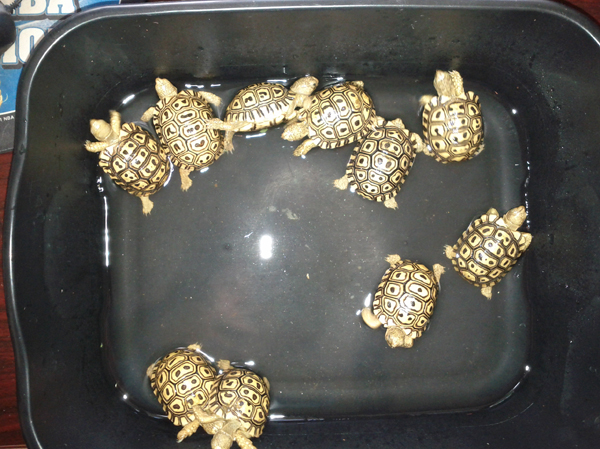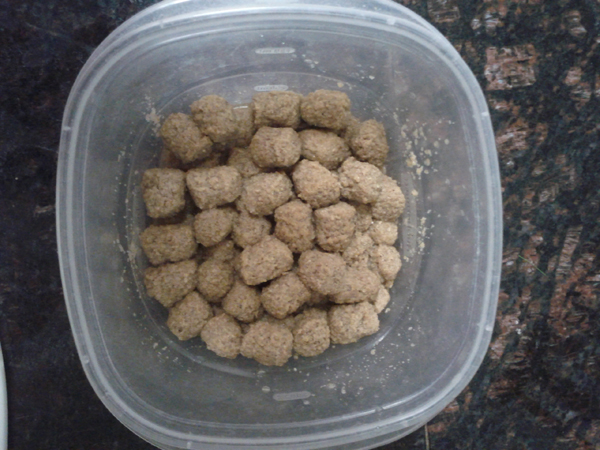Leopard Tortoise Hatchling Tips
Ok so you have just brought home or received from FedEx your brand spanking new baby Leopard tortoise hatchling. Most likely it will weight between 20 and 30 grams and be a couple of weeks old. You are very excited about this new tiny addition but there are a few important things that you need to do to help make sure survival for this fragile little guy.
Warm Water Soaks
It is critical that you give your Leopard tortoise hatchling a warm water (about 85 degrees F) soak for about 30 minutes right when he arrives to your home. If your tortoise arrived via mail, then he has been in his shipping box for about 16 to 24 hours with no drinking water, so he needs to get re-hydrated immediately. If you got him at a pet store or reptile expo, he may have had drinking water but may not have been soaked for several days. Contrary to what you may have read in a book, reptile magazine, other websites, or forums, Leopard tortoise hatchlings require fresh drinking water made available to them at all times. Every Leopard tortoise that I have cared for will readily drink water when made available. Furthermore, if you provide a 20 – 30 minute warm water soak daily, this will help ensure good hydration both internal and external. Another benefit to daily warm water soaks is that they provide some exercise as Leopard tortoises will sometimes try to climb out of their bathing container for several minutes. Just be sure your tortoise bathtub is has high enough sides that they cannot escape. I use plastic dish wash tubs from Walmart that cost about $2. Be sure that you check on them regularly while they soak as sometime they may flip themselves on their back. You want to make the water is only deep enough to go about 1/3 the way up their shell. For a three week old hatchling about 1/2 inch is sufficient. The third benefit is a warm water soak is that it will stimulate bowl movements. This added bonus makes enclosure clean up much easier.

Hatchling South African Leopard tortoises soaking in warm water
After their 30 plus minute soak, place them in to their new home, which of course should have already been set up prior to their arrival, with fresh food and drinking water waiting for them. They will explore a little bit and check out their new surrounding or they may go straight for to the food source. It is a good idea to watch them for several minutes to make sure they appear healthy. It is best to give them a few days with minimal handling so they can adjust to their new surrounding. Over handling of tortoises can stress them which will have an adverse effects on their health.
One interesting thing I have observed is that when a Leopard tortoise hatchling is placed in a new environment, they will exploring it thoroughly the first few days and in the process invariably flip themselves over repeatedly. I have seen this many, many time but they only seem to do this the first 3 days or so. Tortoises have a strong mapping ability and my theory is that while they are learning their new environment, they accidentally flip themselves. Once they know their environment and their limitations in it, they stop accidentally flipping themselves over.
Mazuri Tortoise Diet
Proper diet and nutrition is vital to all living creatures to promote health and longevity and Leopard tortoise hatchlings are no exception. See Leopard Tortoise Diet for a complete diet guide. Here I want to talk about the ‘M’ word Mazuri Tortoise Diet. Some hobbyist are dead set against it as they feel it is not a ‘natural’ tortoise food and other tortoise keepers swear by it and feed it exclusively to their tortoises. There are two types of Mazuri the ‘old’ formula which is Mazuri Tortoise Diet formula code #5M21 and the new Mazuri Tortoise LS Diet formula code #5E5L. I have not tried the new formula yet so my experience is with the old one. I feel that the benefits that they get from eating it out weights any possible negatives. The benefits are:
- When the Mazuri is soaked in water then eaten, the tortoise is sure to be well hydrated internally.
- Once they get used to the flavor most tortoises will love eating it and it will help stimulate appetite if your tortoise ever experiences an illness and is reluctant to eat.
- If you ever have to give liquid medicines like Flagyl (antibiotic) or Panacure (dewormer) just add the drops onto a soaked piece of Mazuri and they will eat their medicine. Trying to force open the beak of a 30 gram hatchling and squirt in medicine with a plastic syringe is no easy feet. I have had to administer medication to hatchlings and I would not have been able to if it weren’t for Mazuri.
- It promotes overall growth and weight gain to help get them through that fragile hatchling stage.
Mazuri Tortoise Diet makes up about 50% by dry weight of what I feed my young Leopard tortoises daily. I soak the Mazuri in water for about 10 minutes or so until it is spongy to the touch then I add cuttlebone powder for calcium, fresh grasses and weeds finely cut with scissors and when I have it, Opuntia cactus. Then mix it all up with my hand and it holds together like a meatball. Most of my Leopard tortoise hatchlings go right for that at feeding but I also offer spring mix, grasses, weeds, leaves, flowers etc. on a separate feeding plate so they get more variety in their diet.
Outside Time in Moderation
Everywhere you look you will read/hear that tortoises need to be outdoors when weather permitting. For Leopard tortoise hatchlings it should be above 70 degrees Fahrenheit. They benefit greatly from fresh air, exercise, and of course sunlight mainly the UVB rays that help them produce D3 that is vital in the metabolism of calcium. All this is 100% true but when dealing with a Leopard tortoise hatchling outdoor time must be regulated for a number of reasons.
First, the outdoor area must be secure from tortoise escape and from predator entry. Leopard tortoises do not dig but they have been known to climb, so you need to make sure they can not get out. Also even if you live in the city there may be predators cruising the neighbor looking for a quick snack. Cats and raptures can make quick work on a tiny tortoise. And trust me tortoises know this instinctively, just pass your arm over them while they are outside and let your arm shadow pass over their head. They will retract into their shell with surprising speed.
Secondly, do not let them get dehydrated. This can happen to Leopard tortoise hatchlings surprisingly quick. In the wild, they spend most other their day under thick bushes or in tall grass out of sight from predators and direct sunlight. I put my hatchlings outside for about two hours at a time, never two consecutive days, and make sure that at least 75% of their space is in the shade. When I bring them back inside, I give them a quick warm water soak for about 10 minutes to help them rehydrate. Getting outside time about three to four times per week has worked for my hatchlings and I do this until they are about 500 grams so that is about until they 12 to 18 months old. Once they are bigger, they can spend more time outside when the weather is permitting.

As you can see, the enclosure is full of tall grasses, broad leaf weeds, and bushes. The wood fence is on the west side which provides the area with nice deep shade starting from about 1:00 p.m. and they don’t go in that enclosure until mid afternoon.

